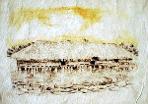The Fare Pōte'e of Maeva
Typical construction of traditional housing, the fare pōte'e, rounded sides fare differs from the fare hau pope, with rectangular shapes. Its dimensions are proportional to the social importance of its occupants.
In Huahine, all traditional types of housing, including fare pōte'e were unearthed at Maeva.
A huge fare pōte'e on stilts was listed by archaeologist Kenneth Emory in 1925, next to the Protestant temple of the village. Used as a meeting house, it was periodically rebuilt by the inhabitants, before decaying completely.
Spurred on by the archaeologist Yosihiko Sinoto the people of Maeva rebuilt it in 1972, a few hundred meters to the west (at the entrance of the village), between the marae Vai-'ōtaha and Rauhuru.
It then evolved over the years into a space more dedicated to cultural activities than to the village social life itself. The painter and singer Bobby Holcomb, along with Marietta Tefaataumarama Mare, Tua Tuarihionoa, and many others... had made a school dance and traditions, mainly for children of the village.
Severely hit by several storms, it was rebuilt in 1996 and 2000-2001, with the impulsion of Ōpu Nui association.
Severely hit by several storms, it was rebuilt in 1996 and 2000-2001, with the impulsion of Ōpu Nui association.

